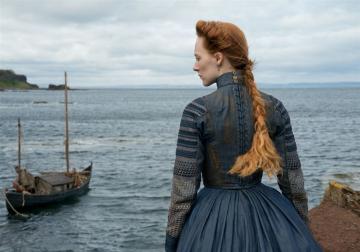Dueling royal redheads make 'Mary, Queen of Scots' worth the while
Dueling regal redheads and their royal wombs are the subject of this week’s British historical action — close on the heels of last week’s dueling ladies-in-waiting in “The Favourite.”
Another century, another Catholic-Protestant struggle in “Mary Queen of Scots.” It opens with formidable Mary Stuart (Saoirse Ronan) — queen of France at 16, widowed at 18 — returning to her native Scotland to reclaim her birthright throne there. Trouble is that, in her absence, both Scotland and England have come under the rule of her equally formidable cousin Elizabeth (Margot Robbie).
“Living side by side, we must do so in harmony,” Mary writes Liz, warning of conspiracies and traitors all around. “Do not play into their hands; our hatred is precisely what they hope for.”
Both young queens live in fear and fascination of each other. As rare female regents in a dangerous male world, they must negotiate the crucial succession game and rivalry for power. Mary’s dynastic claim to the English throne blatantly threatens Elizabeth. Provocative bottom line:
- Starring: Saoirse Ronan, Margot Robbie, Joe Alwyn.
- Rating: R for sexual scenes and battle violence.
“I’ll be the woman she is not,” Mary declares. i.e., she’ll produce an heir — to the thrones of both Scotland AND England.
She’ll also be very militant — downright Joan of Arc-like — in exciting scenes of the 1569 Rising of the North revolt, in which English Catholic nobles in northern England fight for her on barren Scottish battlefields while some fiercely nationalist Scots chant “Abdicate!” — the contemporary equivalent of “Lock her up!” — echoing the belief of many that she was “a traitor and a whore.”
Director Josie Rourke, artistic director of Covent Garden’s Donmar Warehouse, has many acclaimed theatrical productions to her credit. The screenplay is based on John Guy’s book “Queen of Scots: The True Life of Mary Stuart,” whose centerpiece is the climactic scene in which the two queens meet to confront each other and debate their kingdoms’ fates face to face.
“The whole conception of the film for me was around that meeting,” Ms. Rourke has said. The same royal showdown also was at the heart of the original Friedrich Schiller play “Maria Stuart” (1800) and Donizetti opera “Maria Stuarda” (1835), on which Mr. Guy’s book embellishes.
Never mind the fact that it never really happened.
In the title role, Saoirse Ronan is a kinetic embodiment of — by all accounts — the extraordinarily beautiful, clever woman adept at prose and poetry, lute and virginal, horsemanship and falconry, and who knew French, Italian, Latin and Greek in addition to her native Scots, but who was a pawn in the hands of scheming aristocrats on two continents.
Margot Robbie as Elizabeth, with her white clown makeup and worsening pockmarked complexion, is a good match, trying to mediate or at least mitigate Mary’s situation until one-too-many Catholic assassination plots force her to imprison Mary for the last 18 years of her life.
(It sounds bad, and may well have been, but during that time, Mary had a dozen personal chefs who prepared meals with a daily choice of 32 dishes on silver plates.)
BTW factoid: Ms. Ronan and Ms. Robbie competed for the 2018 Best Actress Oscar for “Lady Bird” and “I, Tonya” respectively — both losing to Frances McDormand.
Me, I’ll always retain a soft spot in my heart for Vanessa Redgrave’s Mary and Glenda Jackson’s Elizabeth in the dreamy “Mary Queen of Scots” of 1971. My parents did the same for Katharine Hepburn in John Ford’s “Mary of Scotland” of 1936.
However much the narrative structure lacks here, let’s give Ms. Ronan and Ms. Robbie and the cinematography credit for keeping — however briefly — a head of the game.
Post-Gazette film critic emeritus Barry Paris: parispg48@aol.com.







